The Samsung Galaxy S6 and S6 edge Review
by Joshua Ho on April 17, 2015 9:00 AM EST- Posted in
- Smartphones
- Samsung
- Mobile
- Galaxy S6
- Galaxy S6 Edge
Display
As we briefly discussed in our look at the specifications, the Galaxy S6 line introduces a newer generation of AMOLED displays, which is said to increase maximum luminance to 600 nits. Samsung claims that this was achieved with the use of new materials, which is likely necessary in order to sustain power efficiency improvements. It doesn't seem that AMOLED is uniquely suited to high resolution, but rather that Samsung Display Corp. is managing to dramatically improve how they make AMOLED displays with every year that offset power consumption increases from higher resolution displays.
To find out how Samsung did, we use SpectraCal's CalMAN 5 Ultimate, in addition to X-Rite's i1Pro2 Basic to characterize displays as accurately as possible.
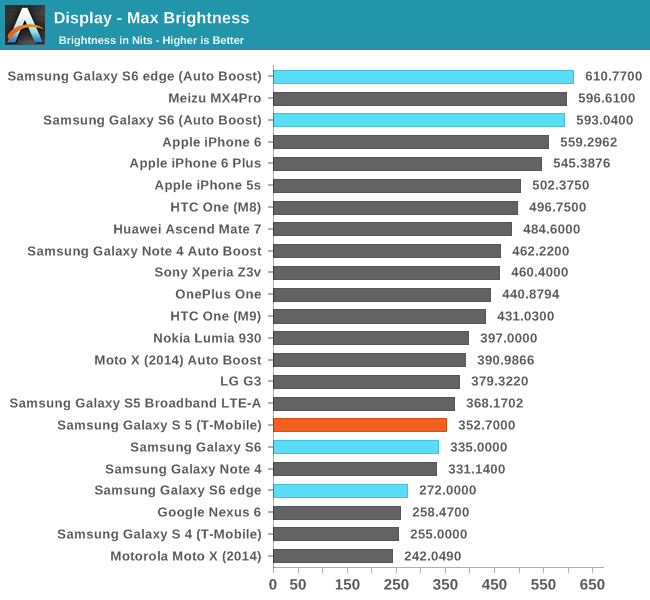
From the results Samsung's claims of a 600 nit display are valid in this case, which is a 100% APL white display. It's important to note that achieving this requires the use of auto-brightness, and that manual brightness is limited to a much lower brightness to reduce power usage, here the S6 sees similar maximum brightness as the S5. The S6 edge disappointingly only achieves 272 nits in this mode, a rather low value. I saw color balance shift dramatically in auto-boost mode, which suggests that this operating mode is likely less efficient than manual brightness. As an explanation, we've seen that colors are controlled in AMOLED by voltage while brightness is controlled by PWM (pulse width modulation). As with most recent AMOLED displays, there's no DC bias to the pixels so the contrast really is infinite instead of just a very large number when displaying black.
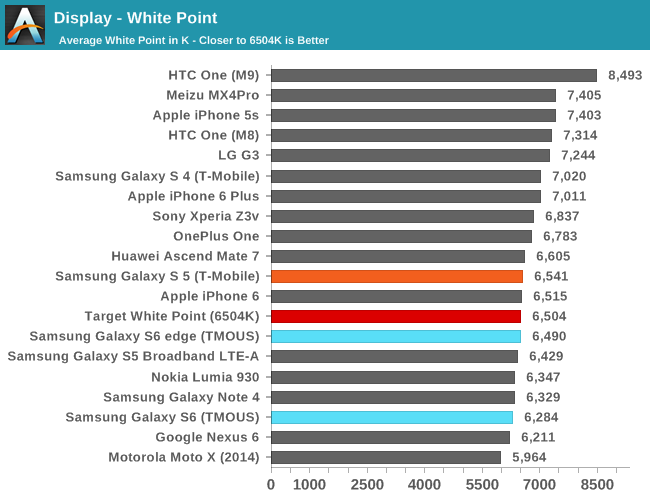

Moving on to grayscale, we can see that Samsung has done a pretty good job of controlling the white point and gamma across the saturation sweep, even if green is slightly dominant in both displays. We can also see that there is variation across displays as the S6 edge is closer to neutral while the S6 sample tends a bit warmer.
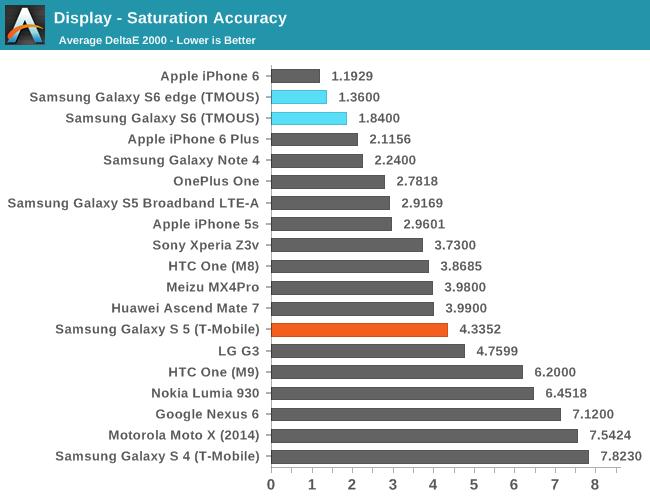
In the saturation sweep, both displays do an incredible job. I really don't have anything else to say here, because there's really no way to improve on the level of calibration Samsung has done on this display. Unless Samsung calibrates every single display in production, which is wildly impractical and effectively impossible to do, this is as good as it gets for a mass-produced device. Improving past this point will also be incredibly difficult to perceive, which means there's no real reason to go any further.
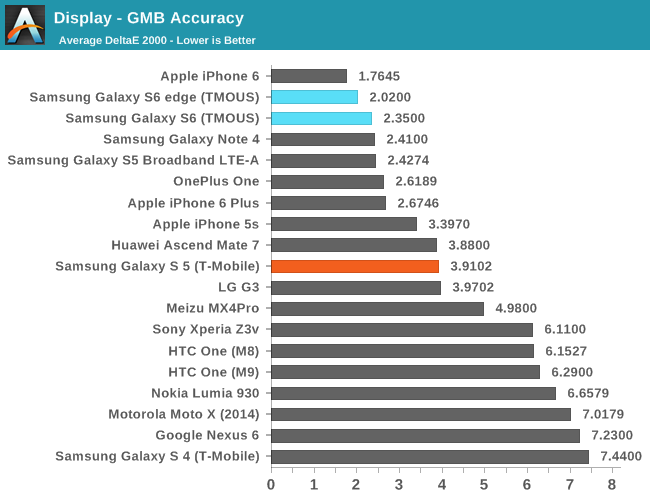
In the Gretag MacBeth ColorChecker, we can get an idea for overall color accuracy, which paints a picture similar to the saturation test. The only real problem I've noticed with these displays are the viewing angles, which can produce color shifting when the display is tilted. This is a bit of an issue on the edge variant as I can see that the edges of the display appear somewhat green when viewed head on, but otherwise there are no real issues to be seen here.
Overall, from a color standpoint it’s looking like Samsung has made one of the best displays available on the market today. Color accuracy is at the point where it’s pretty safe to say that the calibration doesn’t have clear color errors, and the peak brightness of the display is incredibly high. The 1440p resolution helps to compensate for the PenTile subpixel layout so in practice it’s effectively impossible to make out any pixels or the subpixel pattern. The contrast remains infinite as with most modern AMOLED displays, and overall it’s really hard to find any issue with the Galaxy S6’s display at first.
However while the S6 edge seems to be without any issues, the S6 does have some odd display issues that can be seen in direct sunlight as seen in the photo above. To be clear about this the photo above is a simple white screen, which should make the image completely homogeneous but instead there are two visible vertical lines and another jagged horizontal line that appear across the display. Inspection under a light microscope doesn’t really reveal what’s causing this, but the defect is quite visible in practice as seen in the photo above. I suspect that defects are rare, and in any condition other than direct sunlight I can’t see this visual problem.
While trying to see what this kind of defect looked like under a microscope, I also went ahead and took some photos of the subpixel pattern. As far as I can tell, it looks like the green subpixels have a bit more variance than what we’re used to as they tend towards oblong shapes rather than circles, which is likely due to the much tighter pixel density. It seems that this variance may cause some color shifting in certain units, which seems to remain a potential problem with Samsung's AMOLED displays. The pixel fill factor still remains surprisingly low when compared to LCDs, which usually have much higher active area. Due to the subpixel arrangement and some other differences in the display design, color shifting also remains higher than one would expect from LCD displays that are found in phones like the iPhone 6.
The final test that I managed to run on the Galaxy S6 is the brightness vs APL test, which shows the advantage of AMOLED’s emissive nature as it can dynamically increase brightness if the entire display isn’t showing a white screen. As a result, this means that in low APL scenarios like dark movie scenes and app themes it’s possible to see a maximum brightness closer to 700 nits or higher. However, in practice the display’s practical brightness is closer to 600 nits.
Overall, the display is still one of the best on the market, but I would be a bit concerned about fill factor for VR applications as that was a problem on the Note 4. Issues like purple smearing have been resolved, but there are still some problems with the display such as color shifting with changes to viewing angles and some variability in display quality from unit to unit. With this generation I suspect Samsung is either meeting or exceeding the best LCDs in quality, and with the next generation of AMOLED it’s likely that high end smartphones will have to migrate to AMOLED to remain competitive.



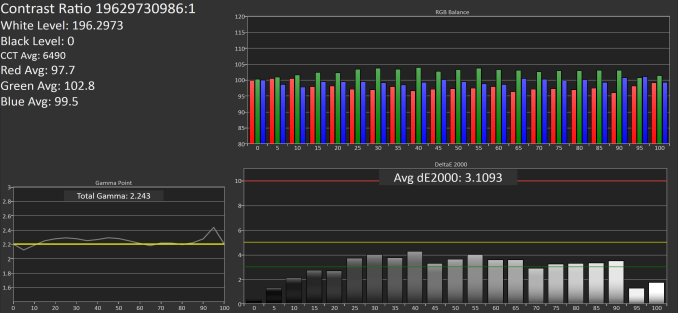
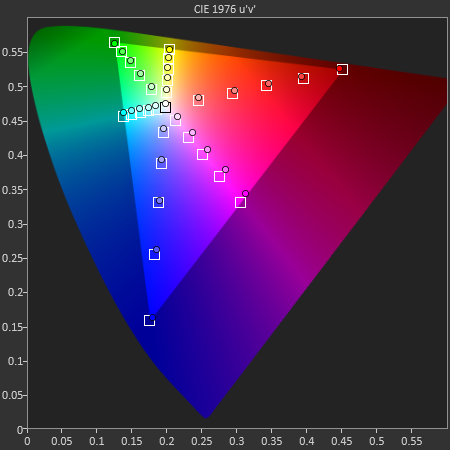
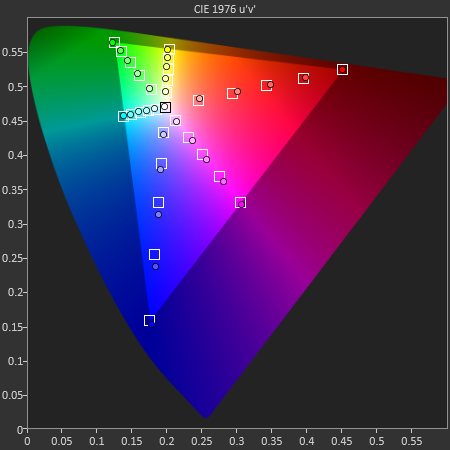
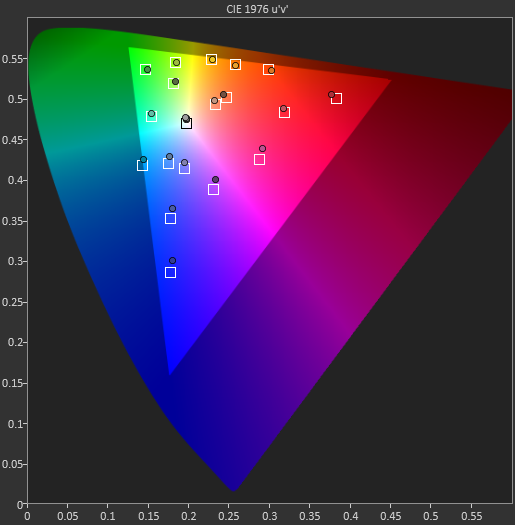

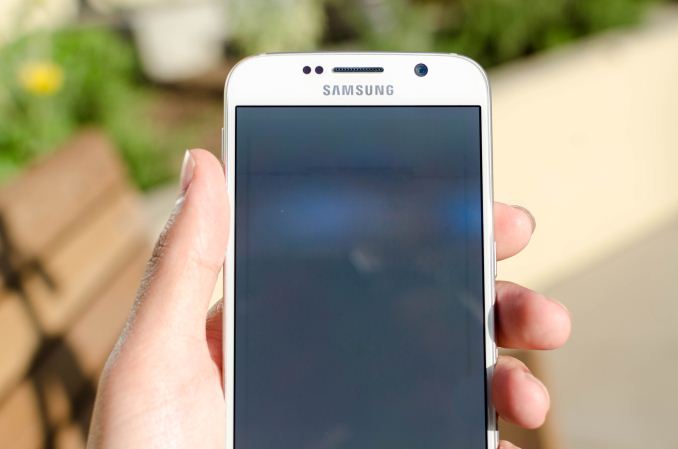
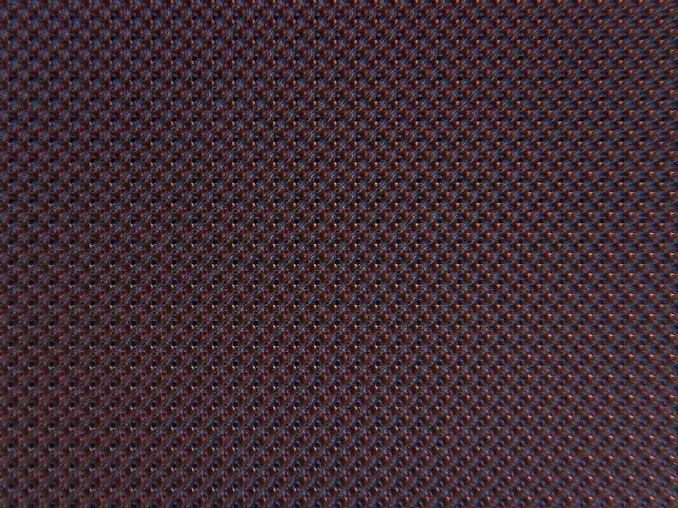
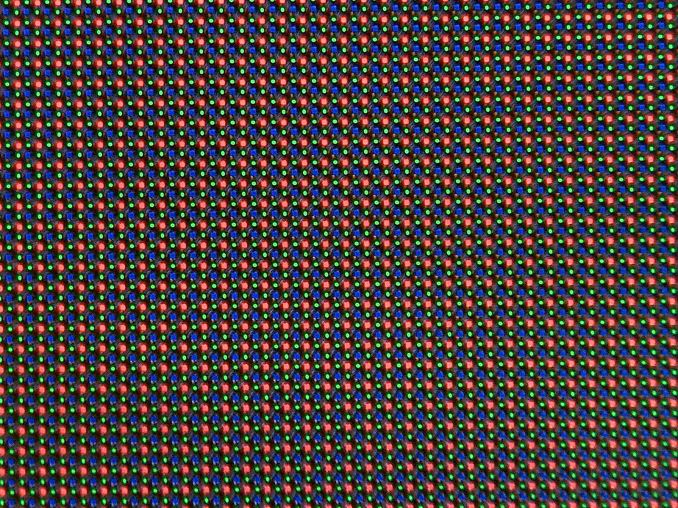
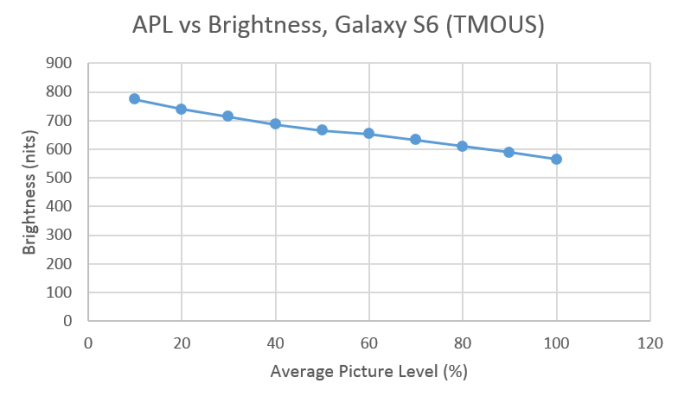








306 Comments
View All Comments
nerd1 - Friday, April 17, 2015 - link
Glad that anandtech FINALLY included the browser benchmarks using sammy's stock browser.lilmoe - Friday, April 17, 2015 - link
It's an improvement. But still, "browser benchmarks" are just that; a benchmark to software side of the browser engine. It's only good for testing CPU performance when we're ONLY looking at generation improvements of the *same* platform/browser/OS.I wish we had a more "open"/transparent cross platform benchmarking suite... Anyway, it looks Exynos is truly back as a market leader, as in being a generation above everything else. I'd expect it to stay in lead well till the Note 5 is here.
nerd1 - Friday, April 17, 2015 - link
"Although the dynamic range of the Galaxy S6’s IMX240 sensor is inherently lower than an equivalent 1.5 micron pixel-size sensor due to the nature of CMOS image sensors"This is not true. Pixel size rarely affects daylight dynamic range of the sensor. D800 series (36MP FF sensor) has actually tiny bit wider dynamic range than 12MP FF sensor of A7s.
Alien959 - Friday, April 17, 2015 - link
Yes, that's true for dslr's because they still have large enough pixel size so dynamic range isn't affected. Even d800 have many times larger pixel photo sensor than 1.5 micron used in SG6. For bigger densities in smaller sensors dynamic range is lower compare some high end compact like panasonic LX7 and cheap point and shoot.nerd1 - Friday, April 17, 2015 - link
Various review sites direct comparison between phone cameras and Note 4/GS6 actually had LESS highlight clipping than iPhone 6.Alien959 - Friday, April 17, 2015 - link
Yes, I have read some of the so maybe sony definitely improved the sensor so samsung is using that versus their own. Different generation sensor and processing also affect the final image.Hairs_ - Friday, April 17, 2015 - link
It's a very hindsight-heavy negative view of the s5 in this review. I'm surprised sales weren't great for it as it fixed most of the issues with the s4's performance and camera.Losing waterproofing, removable battery and SD card are killers for me but apart from that I don't see what makes the s6 a brilliant. The improved software performance will hopefully be brought down to older devices, the improvements in SOC design and battery efficiency are offset by the pointless resolution increase, and the mantra "must follow apple's cue to be considered premium" isn't convincing.
Switching to white backgrounds for apps wastes the advantage of AMOLED as well.
Still, it's selling well so I doubt Samsung care.
lilmoe - Friday, April 17, 2015 - link
The GS5 didn't sell well because of "perception", not merit. It was a HUGE upgrade over the GS4 in almost every aspect IMHO. I'm one of those who actually liked the "band-aid" plastic back. I would have preferred if Samsung made the GS6 closer to the Alpha's design; metal frame with plastic back, but less squarish (IE: the same exact shape/corners of the GS6 but with the same plastic back as the Alpha).I believe that Samsung nailed the design with the Alpha and Note 4, but it seems that reviewers and consumers didn't agree. That stupid twisting of the back cover by reviewers to prove that it was "flimsy" only proved that they were completely ignorant of the quality of materials and the functionality/practicality it entails.
Ammaross - Friday, April 17, 2015 - link
Yep. It's the reviewers that forced Samsung's hand into copying the metal+glass design that the iPhone has. Personally, I think it's horrible as the S6's glass back makes it far too slippery in-hand. I'm definitely putting a bumper on it just so I can hold on to it (which of course entirely defeats the metal+glass design anyway!). Plastic does not mean "cheap," merely flexible (in application/texture, not just robustness).FlushedBubblyJock - Friday, April 17, 2015 - link
Well, yes, I agree, the reviewers had nothing but disdain if it wasn't "the solid and simple apple industrial design that feels expensive in my hand" but add in the drooling sheep and parrots in their responses, they certainly totally contributed as well.Since these people function on mindless perception, not facts, we have the cloned result.